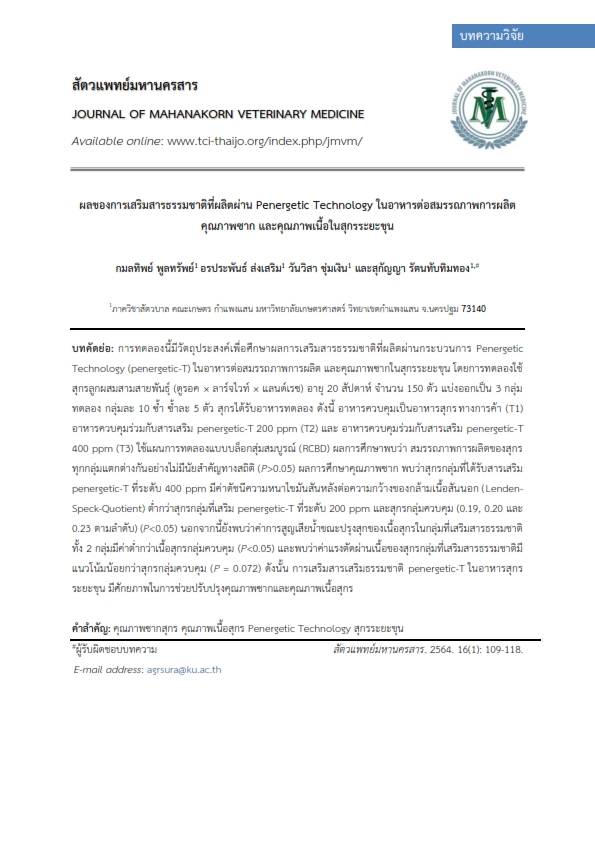Effects of Natural Substance Processed by Penergetic Technology Supplementation in Diet on Growth Performance Carcass Traits and Meat Quality of Finishing Pigs
Main Article Content
Abstract
This trial aimed to evaluate the effects of natural substance processed by Penergetic Technology (penergetic-T) supplementation in diets on growth performance and carcass traits in finishing pigs. A total of 150 Duroc x Large White x Landrace pigs at 20 weeks of age were divided into 3 groups. Each group consisted of 10 replications with 5 pigs per replication. The pigs were randomly fed one of three experimental diets as following, control diet: commercial feed (T1), control diet supplemented with penergetic-T 200 ppm (T2) and control diet supplemented with penergetic-T 400 ppm (T3). The experiment was assigned in Randomized Complete Block Design (RCBD). The results showed no significant differences of growth performance among groups (P>0.05). The results of carcass traits showed that pigs fed diet supplemented with penergetic-T 400 ppm had lower Lenden-Speck-Quotient (LSQ) compared to pigs fed diet supplemented with penergetic-T 200 ppm and pigs fed control diet (0.19, 0.20 and 0.23, respectively) (P<0.05). The values of cooking loss of pork from pigs in the groups of the dietary penergetic-T supplementation were lower than those of pork from pigs in the control group (P<0.05), and shear force values of pork from pigs in the groups supplemented with natural feed additive tended to be lower than those from pigs in control group (P = 0.072). Therefore, supplementation of natural substance processed by penergetic technology (penergetic-T) in finishing pig diet has potential to improve carcass traits and meat quality.
Article Details

This work is licensed under a Creative Commons Attribution-NonCommercial-NoDerivatives 4.0 International License.
References
Anderson, R. A., A. M. Roussel., N. Zouari., S. Mahjoub., J. M. Matheau, and A. Kerkeni. 2001. Potential antioxidant effects of zinc and chromium supplementation in people with type 2 diabetes mellitus. J. Am. Coll. Nutr. 20: 212-218.
A.O.A.C. 1990. Official Methods of Analysis. 15th ed. Association of Official Analytical Chemical, Inc., Virgenia.
Boleman, S. L., S. J. Boleman, T. D. Bidner, L. Southern, T. L. Ward, J. E. Pontif, and M. M. Pike. 1995. Effect of chromium picolinate on growth body composition and tissue accretion in pigs. J. Anim. Sci. 73:2033-2042.
Cogliani, C., H. Goossens, and C. Greko. 2011. Restricting antimicrobial use in food animal: lessons from Europe. Microbe. 6 (6):274-279.
Hanbunchong, A., and A. Sinchermsiri. 1989. Feed analysis and evaluation. Department of Animal science Faculty of Agriculture, Kasetsart University, Bangkok.
Hertog-Meischke, M. J. A., F. J. M. Smulders, J. G. Van Logtestijin, and F. Van Knapen. 1997. The effect of electrical stimulation on the water- holding, capacity and protein denaturation of two bovine muscles. J. Anim. Sci. 75: 118-124.
Jaturasittha, S. 2007. Meat management. 4th ed. Ming muang publishing. Chiang Mai. 170 p.
Kanthapanit, C. 1986. Meat Science. Thaiwatthanapranit, Bangkok. (in Thai)
Khajaren, J. H., S. Khajaren, H. D. Ashmead, and S. P. Ashemead. 2006. The effect of chromium bisglycinate - nicotinamide chelate supplementation on growth and carcass quality in growing and finishing Pigs. Int. J. Appl. Res. Vet. Med. 4(3): 193-198.
Lee, K. W., H. Evert, and A. C. Bevnen. 2004. Essential oils in broiler nutrition. J. Poult Sci. 3: 738-752.
Matthews, J. O., L. L. Southern, J. M. Fernandez, J. E. Pontif, T. D. Bidner, and R. L. Odgaard. 2001. Effect of chromium picolinate and chromium propionate on glucose and insulin kinetics of growing finishing barrows. J. Anim. Sci. 79: 2172-2178.
Meiler, P. 2018. With the impulse of nature. Available source: http://www.penergetic.ca/wp-content/uploads/With-the-impulse-of-nature.pdf, November 15, 2018.
Nuria, V. S., Y. Belguesmia, R. Raspoet, E. Auclair, F. Gancel, I. Kempf, and D. Drider. 2019. Benefits and inputs from lactic acid bacteria and their bacteriocins as alternatives to antibiotic growth promoters during food animal production. J. Front. microbiol. 10: 57.
Office of agricultural economics. 2019. Agricultural production index. Available source : http://www.oae.go.th/view/1/agriculturalproductioninde, May 3, 2020.
Peres, L. M., A. M. Bridi, C. A. Silva, N. Andreo, C. C. P. Barata, and J. G. N. Dario. 2014. Effect of supplementing finishing pigs with different sources of chromium on performance and meat quality. R. Bras. Zootec. 43 (7): 369-375.
Pfeiffer, H., and H. Falkenberg. 1972. Masse am Lenden-spiegel zur objektiven Ermittlung der Schlacht-korperzusammensetzung bei Schwein. Tierzucht. 26:466-467.
Raksasiri, Viliy., J. Sethakul, and R. Sitthigripong. 2005. Effect of dietary chromium picolinate supplemented with iron on the carcass and meat quality of pigs. Kasetsart university. Bangkok. (in Thai)
Sethakul, J., K. Tuntivisoottikul, and R. Sitthigripong. 2003. Grading of pig Carcass by using LSQ. Agricultural Sci. J. 34(4-6): 228-231. (in Thai)
Ward, T. L., L. L. Southern, and T. D. Bidner. 1997. Interactive effect of dietary chromium tripicolinate and crude protein level in growing – finishing pig provided inadequate and adequate pen space. J. Anim. Sci. 57: 1001 –1008.
Zhang, H., B. Dong, and M. Zhang. 2011. Effect of chromium picolinate supplementation on growth performance and meat characteristics of swine. Biol Trace Elem Res. 141: 159-169.


